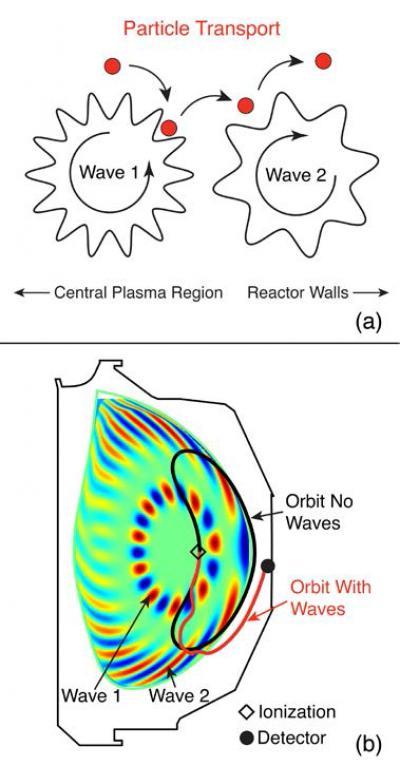Fusion energy requires confining high energy particles, both those produced from fusion reactions and others injected by megawatt beams used to heat the plasma to fusion temperatures.
Experiments at the DIII-D National Fusion Facility in San Diego, California, are shedding light on one of the major mechanisms by which these "fast ions" can be ejected from the plasma. Furthermore, these experiments provide extremely detailed tests of models designed to predict these effects in future reactors.
By arranging their detectors at the edge of a fusion device, researchers have found that they are able to measure high energy particles kicked out of the plasma by a type of wave that exists in fusion plasmas called an Alfvén wave (named after their discoverer, the Nobel Prize winner Hannes Alfvén). The measurements of these lost fast ions also allow for the conclusive identification of the path the particles took en route to the detector, thereby determining which waves (amongst a veritable sea of many different waves) the particles interacted with along their way to the reactor wall. It has previously only been possible to identify interactions between an ion and a single mode, or wave, making the present multiple-wave work an unprecedented view into this fundamental wave-particle physics.

(a) A cartoon shows the influence of one wave on the losses caused by another. (b) Similar situation for losses induced by two different waves in a fusion device and how those particles can hit a detector designed to measure them.
(Photo Credit: Xi Chen)
The basic idea is that a particle bounces from one wave to another through a series of kicks by different waves, ultimately making its way to the edge of the reactor. The rate at which particles are kicked out of the reactor and the location where they hit the wall is a complex combination of each wave's position when the particle reaches it, as well as the initial particle position. In a fusion device, the waves look slightly more complicated but the result is the same. High energy particles are born inside the plasma and, as they undergo an orbit, they intersect two different waves that eventually kick them to the wall and the particle detector. When a particle interacts with two or more waves, the measured losses show an imprint of this that is different than if they had interacted with only one of the waves. By comparing these complex signatures with powerful computer codes developed at the Princeton Plasma Physics Laboratory, Dr. Chen and her colleagues are able to understand with unprecedented detail, the underlying physics involved.
Source: American Physical Society